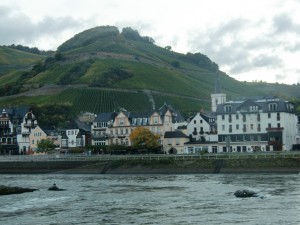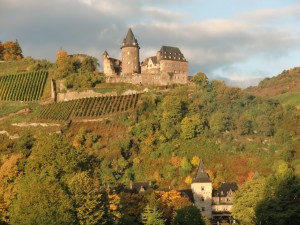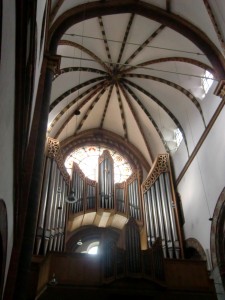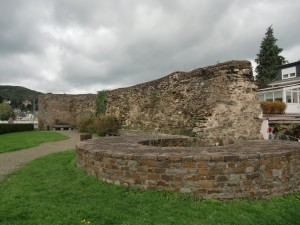CRUISING THE RHINE AND MOSEL RIVERS – CASTLES ON THE RHINE
CRUISING THE RHINE AND MOSEL RIVERS
This is the fourth in a series of articles about cruising the Rhine and Mosel Rivers
CASTLES ON THE RHINE
By Charles N. Stevens
Photos by Dolores Seidman
As we wake up in the morning we’re gliding up the Rhine River, the reflected lights of passing cities wavering on the water. As we look out on the bright lights of one city, a freight train streaks by, the city lights blinking between the cars as the train passes. A coal barge, almost invisible in the darkness, passes us in the opposite direction, only a blue light in front and a red one on the back marking its existence.
As the day dawns, dark clouds swirl over the head lights of cars as their drivers head for work and the beginning of a new day. Everything is in shades of gray, a dashing cormorant appearing black as it flies low over the water. Scattered showers occasionally dampen the deck.
We are now out of the flat land, the Rhine now narrowing and winding through precipitous hills on both sides. We enter a land of vineyards thriving on steep slopes and the ruins of old castles perched on craggy hillsides, some nearly intact, others only vestiges of their former glory. We cruise past Rudesheim, Germany where we had a wonderful time many years ago strolling through its beauty and tasting their mellow white wines.
There are at least fifteen medieval castles along this stretch of the Rhine, Ehrenfels, Reichenstein, Rhinefels, Marksburg and Lahneck castles to name but a few. The poor condition of many of them is the result of the onslaught by the French in the wars of 1869.
In some castles we can see nothing but the sky through the old windows while others have been restored to act as hotels for tourists. Just looking at them high on the ridges, proud but battered, gives us a feeling for medieval times when they served as protective barriers, custom outposts for the traffic on the river, toll collectors and depositories for money.
Halfway up the Rhine Gorge is the famous Loreley, a steep rocky cliff where, as legend has it, a beautiful golden haired maiden sang sweetly, distracting boatman on the Rhine who then perished on the rapids. Heinrich Heine, the noted German poet, composed a poem about it, thereby perpetuating the myth.
But more interesting than myths or the old castles are the vineyards that cover every slope along the river. They are so steep that I wonder how the workers can pick the grapes without falling down the hillsides. As it is late in the season, a few of the vines begin to show yellow leaves, some of them deep red. Most of the grapes grown are Riesling with a smaller amount of Pinot Noir, all very mild and relatively low in alcohol. We see large patches of blue plastic covering portions of a few vineyards, this to protect grapes that will be picked much later so that their sugar will be concentrated, the wine being sold as late harvest.
The clouds have cleared now, the slanting sun lighting up the hillsides and the white and half-timbered houses of the villages on our left, a breathtaking sight. We pass the wine growing cities of Bacharach and Kaub, the visibility excellent, everything before us crisp and distinct.
By late morning we arrive at the town of Boppard where we dock. When the boat is secure, we walk into the city where we are dazzled by the whiteness of the buildings. We tarry at a statue of Schruggel Elsje, a woman who for years handed out sweets to the children who could not afford them. Someone had placed candy in the statue’s outstretched hand.
Most interesting when we reach the town square is the 13th century St. Severus’s Church. Most European Catholic churches seem dark and dull to me, but this one is brilliant white both inside and out. We marvel at the snow white ceiling and walls, the dashes of color projected on the stone floor by the stained glass windows. A rather gory statue of Christ, his head down and bloody, stands outside the church. This one is a pessimistic version, emphasizing that “He died for our sins” while other we had seen with his head raised is more optimistic, pointing out that “He is risen.”
A famous Christmas store lies just off the square, selling tree ornaments, small statues and other Christmas doodads, all at very high prices. But more interesting to me are the Roman ruins at the edge of town, part of them the crumbling city walls that the Romans built to protect themselves from the Germanic tribes.
As we return to the boat for lunch, more rain peppers down. The day, with its alternate showers and sunshine, keeps us guessing. After lunch I gaze out of my cabin window at the sloping vineyards, cloud shadows drifting over them and the ever flowing Rhine. A swift train blazes by, then a slow coal barge rounds a tight bend in the river.
Now on our way again, rain veils the vineyards as a fast train emerges out of the mist along the river’s edge. And in another moment the sun breaks through and paints a vivid rainbow on the opposite shore. We pass several more castles high on the ridges.
In late afternoon we arrive at Koblenz where we round the Deutches Eck and the majestic statue of Kaiser Wilhelm while we slip into the Mosel River, the largest tributary of the Rhine and our “home” for the next several days. We dock close to the old city walls where we’ll remain for the night.

This scene is typical along this portion of the Rhine, small picturesque towns and vineyards thriving on the hillside.

We cruise by one of the fifteen castles along the Rhine, taking us back to medieval times.

We were surprised to look up into the white interior of St. Severus's Church.

These walls built by the Romans to protect themselves from the Germanic Tribes still remain in Boppard.
MONTEREY PARK AUTHOR PUBLISHES 3RD BOOK ABOUT HIS EXPERIENCES IN WORLD WAR II- BACK FROM COMBAT
Charles “Norm” Stevens, a 40 year resident of Monterey Park and World War II Veteran has recently published the 3rd in his series about his experiences in WW II, Back from Combat: A WWII Bombardier Faces His Military Future. This book details the time from when he returned from combat in England where he flew 34 missions over Germany and France until the end of the war. Faced with large numbers of returning combat vets, and not knowing how long the war would continue, the military had to plan for their future. His options were whether to return to combat, become an instructor in the U.S., or receive new training that he would use in the Pacific. The book concludes with the end of the war with an Afterward that includes an update on the B-l7’s still flying in the U.S., as well as present day accounts pertaining to the war.
Stevens is the author of two previous books about his experiences:
An Innocent at Polebrook: A Memoir of an 8th Air Force Bombardier (Story of his 34 bombing missions from his base at Polebrook, England over Germany and France)
The Innocent Cadet: Becoming A World War II Bombardier (A prequel to the first, telling of his training in the U.S. before going overseas into combat.)
He is known to the readers of The Citizen’s Voice as the author of Travel Log Articles including “From Paris to Normandy on the Seine”, “Exploring New York” and “In Search of Snow.” He is retired, having taught for 32 years, primarily in the Montebello Unified School District.
Those interested in purchasing an autographed copy of any of his books, may contact the author at 323-721-8230 or Normstevens24@gmail.com.



